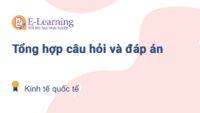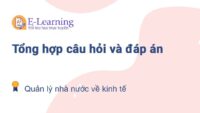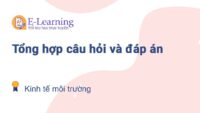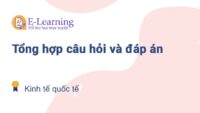Câu hỏi và đáp án môn Lý thuyết dịch EHOU, hỗ trợ học trực tuyến tại Đại học Mở Hà Nội
Hướng dẫn tìm nhanh trên trình duyệt: Ấn Ctrl+F sau đó nhập câu hỏi và nhấn Enter.
Câu hỏi 1: . A number of subdivisions can be also suggested for informative translations, though the principles of ……………………….. here are somewhat different.
- Class
- Classification
- Classify
- Classifying
Câu hỏi 2: . The ideational is subdivided into two components, i.e., “experiential” and “logical”. They convey …………
- Different facts of meanings.
- Different paths of meanings.
- Different roads of meanings.
- Different ways of meanings.
Câu hỏi 3: …………………………………., the theory of translation should be a branch of comparative linguistics. His approach was purely linguistic and textual.
- According for Catford
- According on Catford
- According to Catford
- According with Catford
Câu hỏi 4: ………………………………………………………………………………………., conjunctions do not signal the informa-tion present in the text, rather they signal, by means of “formal markers”, “the way the writer wants the reader to relate what is about to be said to what has been said before”
- As be opposed to reference
- As opposed to reference
- As opposing to reference
- As to being opposed to reference
Câu hỏi 5: A world of …………………………. ………………………..needs translators that beside their specialized knowledge in the two languages, they should also experience intercultural competence.
- Different interacting cultures
- Different interactingly cultures
- Different interaction cultures
- Differing interacting cultures
Câu hỏi 6: According to the frequency analysis, the topical/ideational elements occurred at the most frequent rates followed by …………………………………..and interpersonal elements.
- Text elements
- Texted elements
- Texting elements
- Textual elements
Câu hỏi 7: Analyzing the data ……………………………………………………….marked and unmarked Themes, the result reveals that the number of unmarked Themes by far outweighs the number of marked Themes.
In light of
- In part of
- In some of
- In turn of
Câu hỏi 8: As in the case of referential cohesive devices, the translator also …………………………………………the strategy of deletion while translating the condi-tional conjunction “even if”.
- Made fool of
- Made fun of
- Made part of
- Made use of
Câu hỏi 9: Conjunctive cohesion is the type of cohesion commonly and most extensively dealt with …………………………………………………It is often referred to as “transitional devices.”
In grammar and composition writing.
- In grammar and compositional writing.
- In grammatical and composition writing.
- In grammatically and composition writing.
Câu hỏi 10: Contemporary translation activities of a translator are characterized by a great variety of types, …………….. and levels of his responsibility.
- Formation
- Former
- Forming
- Forms
Câu hỏi 11: Context of situation consists of three aspects: …………………………………………………………. Field refers to what is happening, to the nature of social action that is taking place.
Field, tenor and mode
- Areas , tenor and mode
- Field, road and mode
- Field, tenor and modification
Câu hỏi 12: Context of situation is closely related to various texts. Certain ………………………………………asks for certain text and in return, certain text creates certain context.
Situational context
- Situated context
- Situation context
- Situational contextual
Câu hỏi 13: Different types of translation can be singled out ……………………….the predominant communicative function of the source text or the form of speech involved in the translation process.
- Depended on
- Depending for
- Depending on
- Depending to
Câu hỏi 14: Each language has an area of equivalence in …………………… to the other language.
- Effect
- Means
- Respect
- Way
Câu hỏi 15: Each of these forms of literary activities comprises a number of subgenres and the translator may ……………………………one or some of them in accordance with his talents and experience.
- Come in
- Give in
- Put in
- Specialize in
Câu hỏi 16: Finally, pragmatic understanding is related to ……………………………… ………………………………….In that case, the target does not state what is transferred, but it states the requirement of the process.
The message or implication of a sentence.
- The message or implicative of a sentence.
- The message or implies of a sentence.
- The messager or implication of a sentence.
Câu hỏi 17: Finally, the device of ellipsis ……………………………………………………….omitting informationthat was presented previously, without affecting comprehension:
Consists of
- Consists about
- Consists for
- Consists with
Câu hỏi 18: Furthermore, the fourth device —substitution— is marked bythe use of nouns, verbs or clauses ………………………………….. ……………………………..previously presented. .
- Replace some informations
- To be replaced some information
- To replace some information
- To replacing some information
Câu hỏi 19: Furthermore, words such as hence and so indicate that there is a preceding segment of text presenting a cause or reason, and …………………………………………………
- A followed segment presenting a result.
- A following segment presenting a result.
- A following segmental presenting a result.
- A following segmentation presenting a result.
Câu hỏi 20: In addition to reading comprehension ability, the knowledge of specialized subjects ……………………………………………….and a wide cultural background, and the global vision of cross-cultural and interlingual communication.
Derived from specialized training
- Derived about specialized training
- Derived around specialized training
- Derived with specialized training
Câu hỏi 21: In most cases, a translator decodes a text …………………………………………, conditioned by his ideology and world knowledge
- According for his understanding
- According on his understanding
- According to his understanding
- According with his understanding
Câu hỏi 22: In regard to reference, the Target Text tends ……………………………………………………………………that are equivalent to the ones used in the Source Text.
- To present cohesive devices
- To presentation cohesive devices
- To presentative cohesive devices
- To presenting cohesive devices
Câu hỏi 23: In the process of communication, the meaning system is largely determined ……………………… ………………situational context: ideational meaning by field, interpersonal meaning by tenor and textual meaning by mode .
- By the five aspects of
- By the four aspects of
- By the three aspects of
- By the two aspects of
Câu hỏi 24: In translation, there should be no change in the ………………………of narration or in the arrangement of the segments of the text.
Sequence
- Path
- Play
- Road
Câu hỏi 25: It is ……………………. that the translation has the same meaning as the original text.
- believe
- presumed
- think
- understand
Câu hỏi 26: Literal translation ……………………………….word to word; group to group; collocation to collocation; clause to clause; sentence to sentence. The smaller the unit, the commoner the approach, following the basic translation procedures.
Ranges from
- Ranges about
- Ranges around
- Ranges for
Câu hỏi 27: Literary translation deals with literary texts, i.e. works of fiction or poetry whose main function is to make an …………………….. or aesthetic impression upon the reader.
- Emotion
- Emotional
- Motion
- Moving
Câu hỏi 28: Literary translations may be subdivided in the same way, as each genre calls for a specific arrangement and …………………… ……………..specific artistic means to impress the reader.
Makes use of
- Makes useful of
- Makes usefulness of
- Makes using of
Câu hỏi 29: Mode refers to what part the language is playing, what it is that the participants are ………………………………………in that situation: the symbolic organization of the text, the status that it has, and its function in the context.
- Be expecting the language to do for them
- Expectation the language to do for them
- Expected the language to do for them
- Expecting the language to do for them
Câu hỏi 30: Similarly to pronoun reference, the cohesive device of conjunction proves …………………………………………………………….. of the Target Text.
- Be problematic for the translator
- To be problem for the translator
- To be problematic for the translator
- To problematic for the translator
Câu hỏi 31: Technical and scientific translation has traditionally been the dogsbody of theoretical discussions of translation. The underlying rationale when approaching this type of translation has usually been that literature ………………………..a creative elaboration of language.
Involves
- Involvedly
- Involvement
- Involving
Câu hỏi 32: Technical translation is a type of involving the of documents …………………………………….. (, , etc.), or more specifically, texts which relate to technological subject areas or texts which deal with the practical application of scientific and technological information.
Produced by
- Being producing by
- Producing by
- Production by
Câu hỏi 33: Text is a meaningful unit, but to guide persons towards meanings it is recommended to start from …………………………………………………………………………after that inspect the STs and their probable translation.
- The lexico-grammar realizations analysis,
- The lexico-grammatical realizations analysis,
- The lexico-grammatical realizing analysis,
- The lexicology-grammatical realizations analysis,
Câu hỏi 34: The …………………. of the translation should follow that of the original text.
- Causes
- Reasons
- Results
- Structure
Câu hỏi 35: The concept of context has been extensively studied by different linguists from …………………………………….., such as pragmatics and systemic-functional linguistics.
Different perspectives
- .Different minds
- Different thinkings
- Different trials
Câu hỏi 36: The device of substitution was not extensively used’ in either text. Only the ST employed it once, …………………………………..
- To using the verb “do”
- Usage the verb “ do”
- Uses the verb “do”
- Using the verb “ do”
Câu hỏi 37: The distinctive relationship between ……………………………………………….is established by the ability of translation to approximate a multilingual communication to a monolingual one.
- The origin and translation
- The original and translated
- The original and translating
- The original and translation
Câu hỏi 38: The model identifies three main functions that speakers/ writers uselanguage for: ……………………………………………………….. to encode interaction and to organize theprevious functions into a coherent whole.
To represent experience,
- Representing experience,
- To present experience,
- To represented experience,
Câu hỏi 39: The multiple Theme or split Rheme pattern was used at the most frequently. This indicates that the multiple Theme or split Rheme patterns are ……………………………….
- Dominant in thetexts.
- Dominated in the texts.
- Dominating in thetexts.
- Domination in thetexts.
Câu hỏi 40: The original text may deal ……….. ………….any subject from general philosophical principles or postulates to minute technicalities in some obscure field of human endeavour.
- About
- For
- Of
- With
Câu hỏi 41: The problem of empty Theme, the problem of the brand new Theme, the problem of overuse of constant progression, the problem of empty Rheme, and …………………………….
- The difficulty of confusing selection of textual Theme.
- The easiness of confusing selection of textual Theme.
- The problem of confusing selection of textual Theme.
- The thing of confusing selection of textual Theme.
Câu hỏi 42: The process of ………………………………………………..in a target language involves both lexico-grammatical and pragmatic analysis.
- Decode a text andencoding it
- Decodification a text andencoding it
- Decoding a text andencode it
- Decoding a text andencoding it
Câu hỏi 43: The relation between the two segments will be one of reason-result. ……………………………………………………………………………….substitution and ellipsis cohesion ties, which are meant to signal only one phoric relation at a time (with the exception of a pronoun, which can act in anaphoric, cataphoric, or exophoric reference,
- Dislike reference,
- to like reference,
- Unlike reference,
- Unliked reference,
Câu hỏi 44: The source language ……………….. of cultural context and situational context.
- Consists
- Contain
- Contents
- Have
Câu hỏi 45: The study is devoted to the exploration of English writing skill which sets out to obtain some concrete information on the students’ problems in writing English ……………………………………
- Support by Systemic Functional Grammar.
- Supported by Systemic Functional Grammar.
- Supporting by Systemic Functional Grammar.
- Supposed by Systemic Functional Grammar.
Câu hỏi 46: The topical Theme is divided into two subtypes: …………………………………………………………..Simple marked Theme refers to when a topical element is chosen for foregrounding while simple unmarked Theme refers to that which is most usual.
- Unmark andmarked Theme.
- Unmarked andmark Theme.
- Unmarked andmarked Theme.
- Unmarked andusual Theme.
Câu hỏi 47: The transformational model postulates that in any two languages there is a number of nuclear structures which are fully …………… … …. …….. each other.
- Equivalent for
- Equivalent of
- Equivalent to
- Equivalent with
Câu hỏi 48: The use of multiple Themes is one of …………………………………………………………of writing exposition, helping the writers in their attempts to persuade the readers.
The characteristic features
- The character features
- The characteristic featuring
- The characteristically features
Câu hỏi 49: The writers used multiple Theme by ………………………………………..to topical Theme to create connectedness in the text. As a result, it provides the writers with an effective way to convey information circulated in the written text.
- Adding text Theme and interpersonal Theme
- Adding textual Thematic and interpersonal Theme
- Adding textual Theme and interperson Theme
- Adding textual Theme and interpersonal Theme
Câu hỏi 50: Thematic progression helps give cohesion and thus coherence to a text, guiding the reader through the text …………………………………………
- In a logical and ration course.
- In a logical and rational course.
- In a logical and rationally course.
- In a logically and rational course.
Câu hỏi 51: Thematic structure includes Theme and Thematic progression patterns, information structure includes …………………………………………….and cohesion includes reference, conjunction, ellipsis and lexical cohesion.
Given and new units of information
- Give and new units of information
- Given and take units of information
- Given and taken units of information
Câu hỏi 52: Theme ……………………………………………which is optional followed by the interpersonal element which is optional and followed by a topical/ ideational element which is obligatory.
Consists of the textual element
- Consists about the textual element
- Consists for the textual element
- Consists on the textual element
Câu hỏi 53: Theme and Rheme boundary is a sequential ordering and range of possible groups or phrases that use for setting ……………………… ………………………….structure.
- Tenor and Rheme
- Theme and Modality
- Theme and Mood
- Theme and Rheme
Câu hỏi 54: Theme can be identified in terms of three metafunctions: …………………..
- Ideation,interpersonal and textual.
- Ideational, interpersonal and textual.
- Ideational,interperson and textual.
- IDeational,interpersonal and text.
Câu hỏi 55: There are also omissions, partial equivalences and even complete alterations of ……………………………………………………………………in the ST.
- The being connected signaled by the cohesive device
- The connecting signaled by the cohesive device
- The connection signaled by the cohesive device
- The connective signaled by the cohesive device
Câu hỏi 56: Translation …………………… is an academic interdiscipline dealing with the systematic study of the theory, description and application of , , and .
- Learn
- Studies
- Tutoring
- Work
Câu hỏi 57: Translation is a ………….. of actions performed by the translator while rendering the source text into another language.
- Branch
- part
- Set
- Wing
Câu hỏi 58: Translation is a …………………….. of interlingual communication.
Means
- Direction
- Seed
- Wing
Câu hỏi 59: Translation shifts ………………….. both at the lower level of language, i.e. the lexicogrammar, and at the higher thematic level of text.
- Drive
- Find
- Occur
- Run
Câu hỏi 60: Translators need ……………….. ……………………………………………that help to achieve their goals in enhancing communication across different nations.
To encompass a diversity of factors
- Encompass a diversity of factors
- Encompassing a diversity of factors
- To encompassing a diversity of factors
Câu hỏi 61: Translators should be skilled to handle the challenge of intercultural associations, which in a way incorporates forces of ……… …………………………………………………and many other historical and societal factors.
Politics, economics, religion, poetics, ideology,
- Political, economics, religion, poetics, ideology,
- Politics, economical, religion, poetics, ideology,
- Politics, economics, religious, poetics, ideology,
Câu hỏi 62: Translators usually have to deal with six different problematic areas in their work, …………………………………they are translating technical documents or a sworn statement.
Whether
- How
- What
- When
Câu hỏi 63: Transliteration is the process rendering the letters of one alphabet in terms of the letters of another with a different alphabetical system. In transcription the pronunciation of …………………………………………is transcribed in the alphabetical system of the Target Language.
- The Course Language word
- The Resource Language word
- The Source Language word
- The Source Linguistic word
Câu hỏi 64: Unlike reference, ellipsis, substitution and conjunctive cohesion, lexical cohesion is notassociated with any special syntactic classes of elements. It is therefore …………………………………………………………………..and least adequately defined of the five kinds.
The most open-ended
- The most open-ending
- The most opening-ended
- The most openly – ended
Câu hỏi 65: While the presence of specialized is a feature of technical texts, specialized terminology alone is not ……………………………………. classifying a text as “technical” since numerous disciplines and subjects which are not “technical” possess what can be regarded as specialized terminology
- Insufficiency for
- Sufficiency for
- Sufficient for
- Sufficiently for
Câu hỏi 66: Word-for-word translation transfers Source Language grammar and ……………………………., as well as the primary meanings of all the Source Language words into the translation, and is normally effective only for brief simple neutral sentences.
Word-order
- Word-arrangement
- Word-boundary
- Word-line





